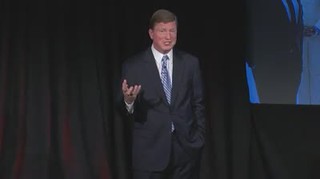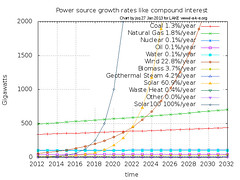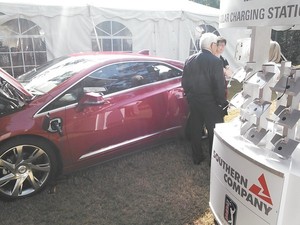People are starting to wake up as the solar sun rises above their horizon. This could be the year the Georgia legislature finally passes a bill to amend the law that inhibits solar financing. Even the City of Valdosta seems suddenly interested in helping with that.
Michael Caputo and Grant Blankenship, GPB, 12 December 2014, (VIDEO) Will Solar Power’s Surge in Georgia Make It To Homeowners?,
Early adopter Creighton Rosental of Macon is what you’d call a solar pioneer. The early adopter said that he had the 4-kilowatt panels installed on the backyard side of his roof about five years ago. Two-thirds of the upfront cost—about $30,000—was covered by a federal tax credit and a Georgia state credit.
“They built a frame and mounted it to the roof, which was a substantial fairly substantial enterprise.” Rosental said.
He actually sells the solar power generated back to Georgia Power and then gets a credit on his bill.
“We’re essentially a mini power plant,” he said.
Five years ago this collection system was so exotic, Rosental said, that it seemed as though local Georgia Power employees didn’t know how to hook-up meters to read both the production of the solar power and the energy his home used.
“A lot of people at Georgia Power didn’t know anything about solar,” he said
Tell me about it. In 2009 there were only four certified solar installers in the entire state of Georgia. Now there are hundreds, including a couple in Valdosta and one in Adel.
It’s good to see somebody else following Southern Company CEO Tom Fanning’s gradual inching towards solar power.
But Georgia Power and its parent “ the Southern Company “ have certainly been paying closer attention to solar power, primarily because of its tumbling price. The drop took everyone by surprise.
 It certainly didn’t take Tom Fanning by surprise, since
at the 22 May 2013 SO stockholder meeting, in response
to a question by me,
Fanning announced a tiger team to come up with a business model
for distributed solar and wind energy. He said it would report back that
same summer.
At that same meeting I said “I know you know what Moore’s Law is”
and he nodded; being a former Chief Information Officer of course
he knows how Moore’s Law drove the exponential adoption of
computers, PCs,
the Internet, smart phones, and tablets,
and how it’s driving solar power deployment now.
And of course, as CEO of the second largest (by retail sales) electric
utility in the country, he knew about
the January 2013 report by utility think-tank Edison Electric Institute
saying rooftop solar is a disruptive factor on the century-old
baseload-capacity utility business model.
That (and the rocketing rise of SolarCity’s stock) is why he appointed
that tiger team.
It certainly didn’t take Tom Fanning by surprise, since
at the 22 May 2013 SO stockholder meeting, in response
to a question by me,
Fanning announced a tiger team to come up with a business model
for distributed solar and wind energy. He said it would report back that
same summer.
At that same meeting I said “I know you know what Moore’s Law is”
and he nodded; being a former Chief Information Officer of course
he knows how Moore’s Law drove the exponential adoption of
computers, PCs,
the Internet, smart phones, and tablets,
and how it’s driving solar power deployment now.
And of course, as CEO of the second largest (by retail sales) electric
utility in the country, he knew about
the January 2013 report by utility think-tank Edison Electric Institute
saying rooftop solar is a disruptive factor on the century-old
baseload-capacity utility business model.
That (and the rocketing rise of SolarCity’s stock) is why he appointed
that tiger team.
 The next day, AP
reported Standard & Poor’s lowered Southern Company’s rating from
stable to negative, due to unrecovered cost overruns on Kemper Coal in
Mississippi, potential for the same at nuclear Plant Vogtle in Georgia,
and implicitly because of lack of enough shift to renewable solar and
wind power.
The next day, AP
reported Standard & Poor’s lowered Southern Company’s rating from
stable to negative, due to unrecovered cost overruns on Kemper Coal in
Mississippi, potential for the same at nuclear Plant Vogtle in Georgia,
and implicitly because of lack of enough shift to renewable solar and
wind power.
Other stock analysts were quite explicit about SO’s lack of emphasis on renewable energy.
And 11 July 2013 the Georgia Public Service Commission required Georgia Power to double the amount of solar power it would buy, after strong suggestions from throughout the state, and despite a failed astroturf campaign against by fossil fuel companies.
 21 August 2013, Chairman of the Federal Energy Regulatory Commission (FERC)
Jon Wellinghoff predicted
“Solar is growing so fast it is going to overtake everything.”
How soon? Within a decade, he said,
matching
my previous prediction
within one year.
In April 2014
data from the U.S. Energy Information Administration (eia)
showed that
U.S. solar capacity grew more than 400% in 4 years,
proving Wellinghoff right.
21 August 2013, Chairman of the Federal Energy Regulatory Commission (FERC)
Jon Wellinghoff predicted
“Solar is growing so fast it is going to overtake everything.”
How soon? Within a decade, he said,
matching
my previous prediction
within one year.
In April 2014
data from the U.S. Energy Information Administration (eia)
showed that
U.S. solar capacity grew more than 400% in 4 years,
proving Wellinghoff right.
 Solar charging stations for cars were featured at the
28 May 2014 Southern Company stockholder meeting,
and Tom Fanning told everyone he drives a Tesla now.
But when I asked him about that tiger team report,
he said it was released internally, and it’s true he never
said it would be public.
The current executive in charge of that team said if they
released it publicly they would have to redact it so much
there wouldn’t be left, because it was “brutally honest”.
That’s the problem: Southern Company’s centralized utility
business culture
has a hard time adapting or incorporating distributed
rooftop solar power.
Solar charging stations for cars were featured at the
28 May 2014 Southern Company stockholder meeting,
and Tom Fanning told everyone he drives a Tesla now.
But when I asked him about that tiger team report,
he said it was released internally, and it’s true he never
said it would be public.
The current executive in charge of that team said if they
released it publicly they would have to redact it so much
there wouldn’t be left, because it was “brutally honest”.
That’s the problem: Southern Company’s centralized utility
business culture
has a hard time adapting or incorporating distributed
rooftop solar power.
Back to the GPB article:
Just a year ago, Southern Company CEO Tom Fanning told the Energy Information Administration Conference that it will take some time for solar to be price competitive.
“For the southeast where we have nine and a half cent power on the average. It will probably be limited in its penetration until the end of the decade, 2018… 2020,” he said then.
In its filing with the PSC, Georgia Power wrote that these bids show solar can “provide competitive pricing when challenged to do so.”
It’s Georgia Power and Southern Company that are being challenged to come up with a business plan that incorporates solar power, before solar eats their lunch.
The GPB story continues about Paul Wolff of the Tybee Island Council, including:
The city has plugged into a nationwide program called Solarize. Tybee Island would buy solar panels in bulk and offer them to interested residents at a reduced cost. It’s the first solarize program in the state. Paul Wolff, a Tybee Council member, said other cities that have done a Solarize project quickly see interest spread beyond their borders.
Solar’s rapid drop in price certainly didn’t surprise Paul Wolff, who told LAKE 17 February 2012 that he had invested in solar panels because:
I did the math on it ahead of time. I had a bunch of mutual funds that hadn’t done anything in a long time. I figured out given the state and federal tax credits what the payback would be, and it came out to be about eight years. So I just divided that out, and by selling mutual funds and investing that money in solar panels on my roof it’s an eleven percent return. And in this economic climate I have nothing else yielding anywhere near that. So that’s a selling point.
Here’s a video tour of Paul Wolff’s weatherstripping and solar installation.
The GPB story continues:
And Roger [sic] Green, CEO of Greenavations and a solar advocate, said market forces will make it likely that homeowners ultimately see some benefit from solar.
“I got asked by some people, some political people just what exactly was this gift that god gave to the south,” he said.
 Solar’s rapid rise certainly didn’t surprise Robert Green, who was
a main speaker at
a Solar Energy Forum in Savannah, 1 December 2012 (see videos).
Solar’s rapid rise certainly didn’t surprise Robert Green, who was
a main speaker at
a Solar Energy Forum in Savannah, 1 December 2012 (see videos).
The GPB story concludes:
Meanwhile the leasing option “ the Power Purchase Agreement “ will again go before the state legislators in 2015.
 As it has every year since about 2000.
See other post about some solar bills in recent years.
As it has every year since about 2000.
See other post about some solar bills in recent years.
This could be the year that antique 1973 Territorial Electric Service Act that prevents solar financing finally gets fixed. And you can help!
-jsq
Short Link: